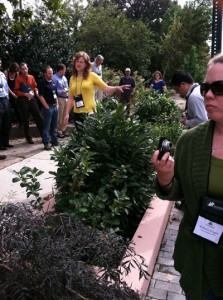G3’s Pamela Berstler was in Philadelphia speaking at the Low Impact Development Symposium 2011 last week, and had a chance to see the new $6 billion Philadelphia Green Infrastructure Initiative up close.
Like many East Coast cities, Philadelphia has a combined sewer and stormwater system (Combined Sewer Overflow – CSO). So, rainstorms of even 1″ can be huge flooding and pollution events.
Residents in many Philadelphia neighborhoods (primarily older neighborhoods and many disadvantaged communities) have no more than 26′ between houses on a street (including sidewalks). These are incredibly tiny! So, the LID solutions need to be simple and streamlined. There is not a lot of room for planting; in many cases the solution will be pervious concrete or asphalt. The first pervious asphalt installation in the city required the complete renovation of the street and adjacent sidewalk. The street was widened from 6’3″ to 7’6″ and covered with pervious asphalt.
Even then, flooding is not entirely eliminated because Philadelphia building code requires roof downspouts to be connected directly to the sewer lines.
One thing clear from the trip around town is that community buy-in and “ownership” of these projects is paramount to both the ease of installation and the long-term success. Under a mandate from Mayor Nutter, Philadelphia Water & Power (PWP) is working on these projects with Parks & Recreation. One large project converted a community swimming pool and basketball court into a spray park with permeable asphalt court and large sponge garden. The project cost the City $3 million, but the water savings from the spray park and the pollution prevention from the LID BMPs is enormous. Now PWP is faced with organizing long-term stewardship of the site. It is not clear that the City looks at these BMPs as workforce development opportunities or truly understands the importance of integrating the construction of these projects into the social life of the surrounding community. The BMPs are solving problems in the immediate future, so aren’t PWP’s goals met?
The challenge is to develop local non-profit and community organizations that have the bandwidth, considering the astounding extent of poverty and related concerns, to educate and engage the local community in the role of green infrastructure for improving the quality of life throughout the city. The Philadelphia experiment in Green Infrastructure will be as much an experiment in creative implementation of LID as an experiment in Brotherly Love of Green Spaces.



